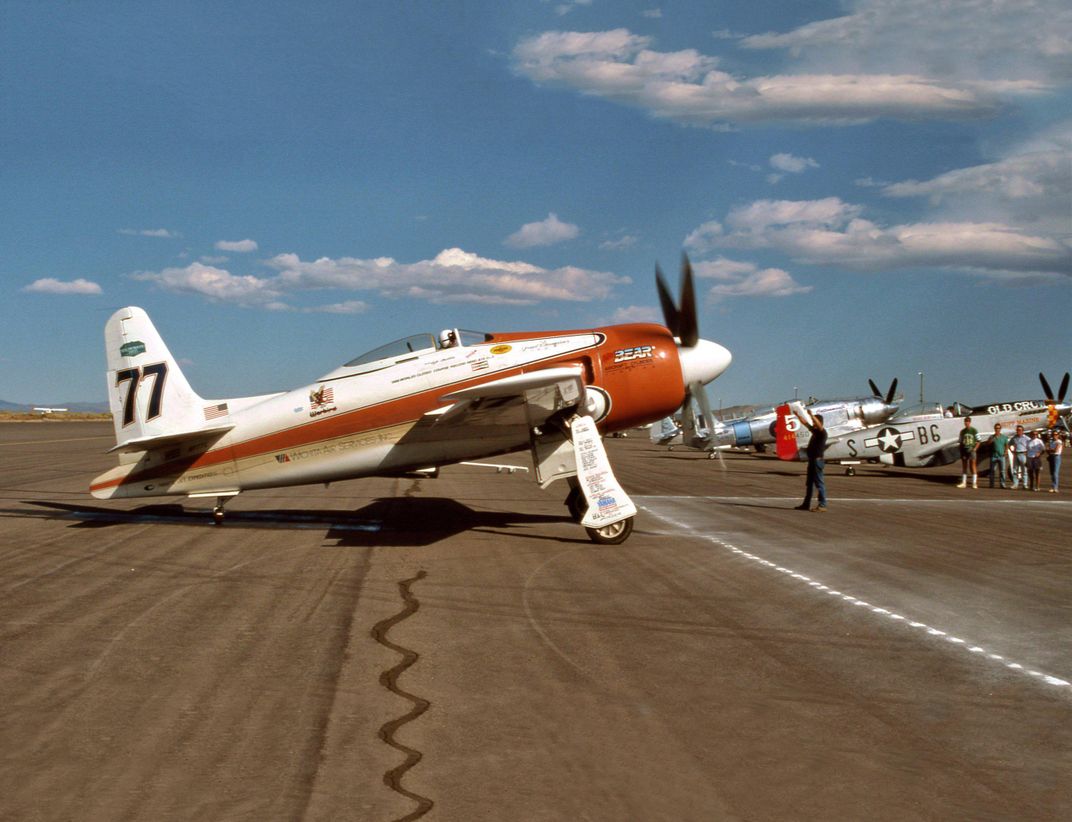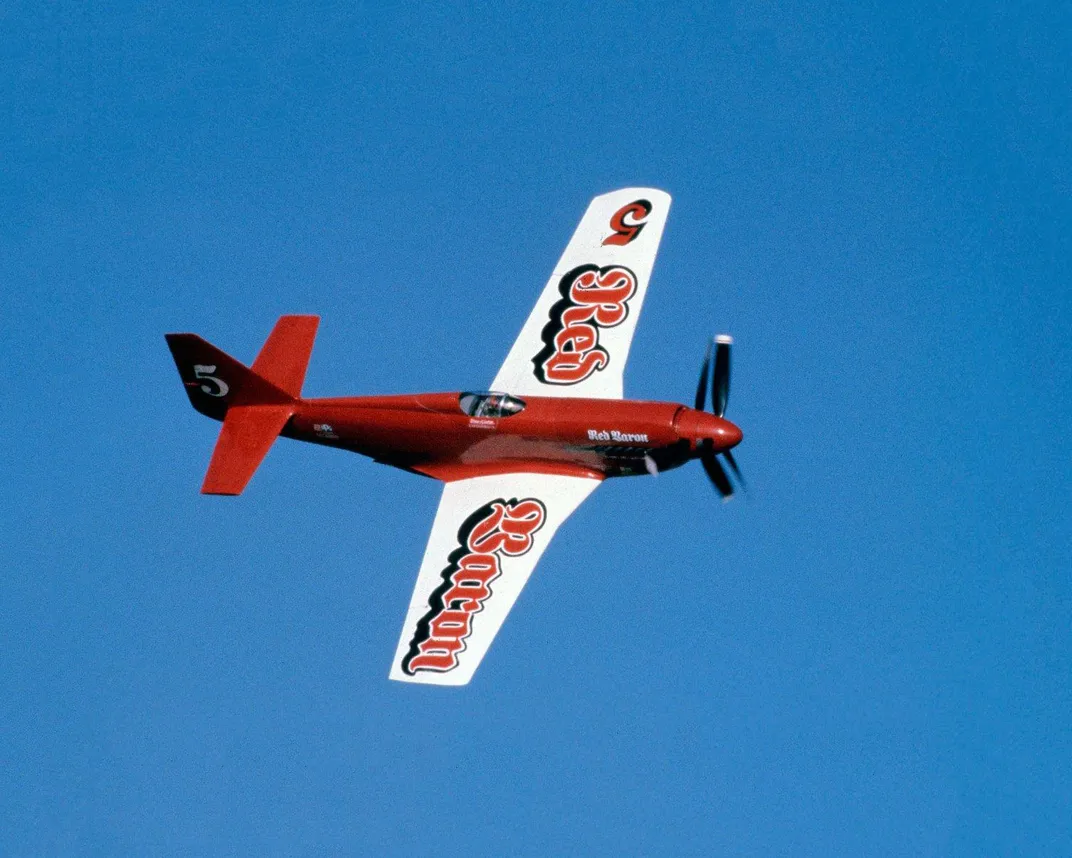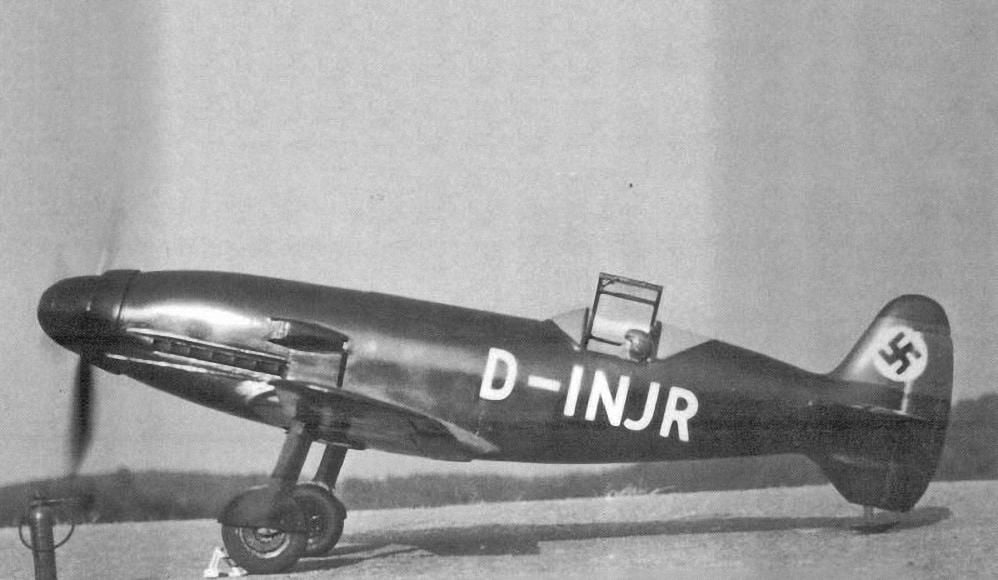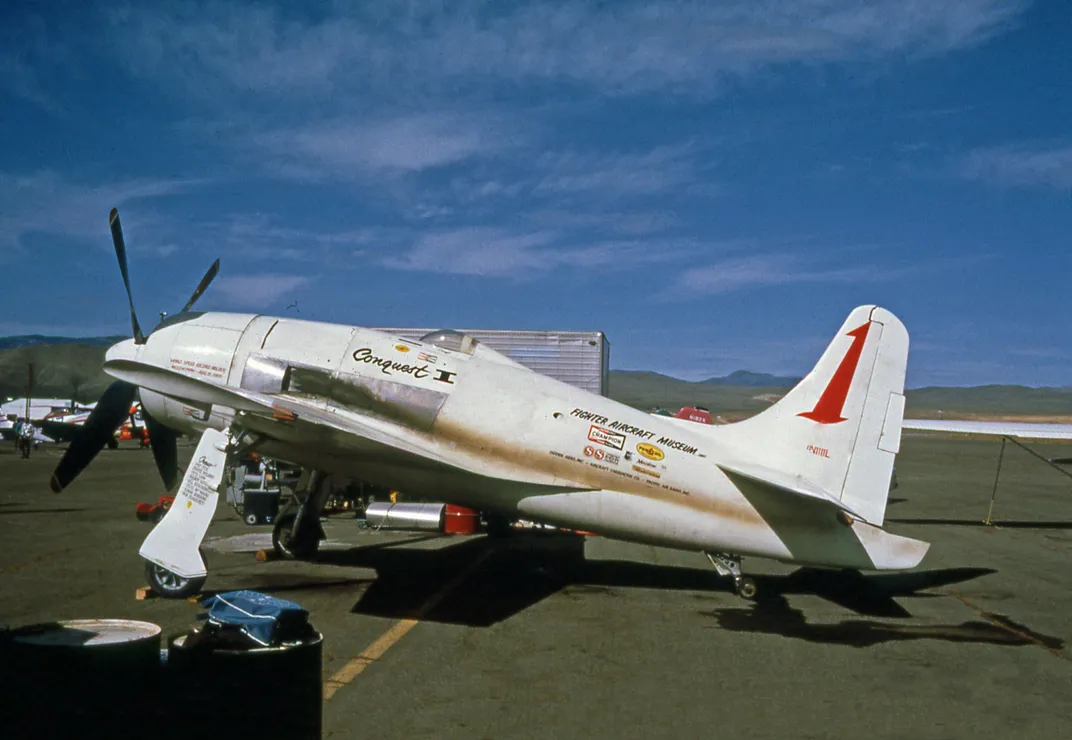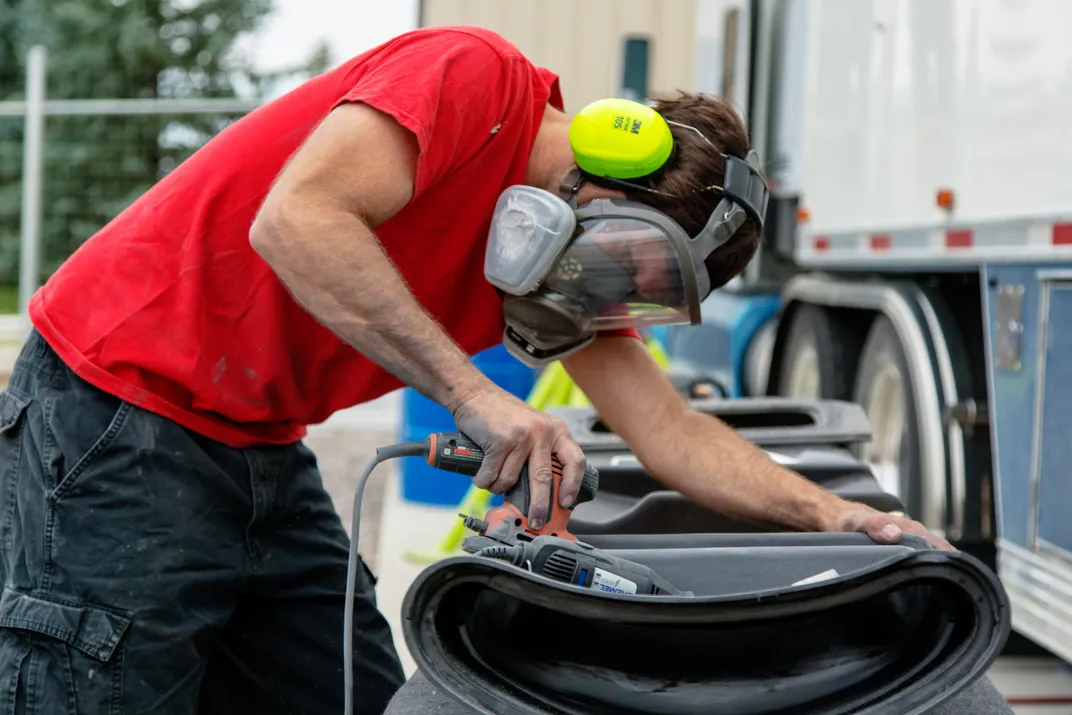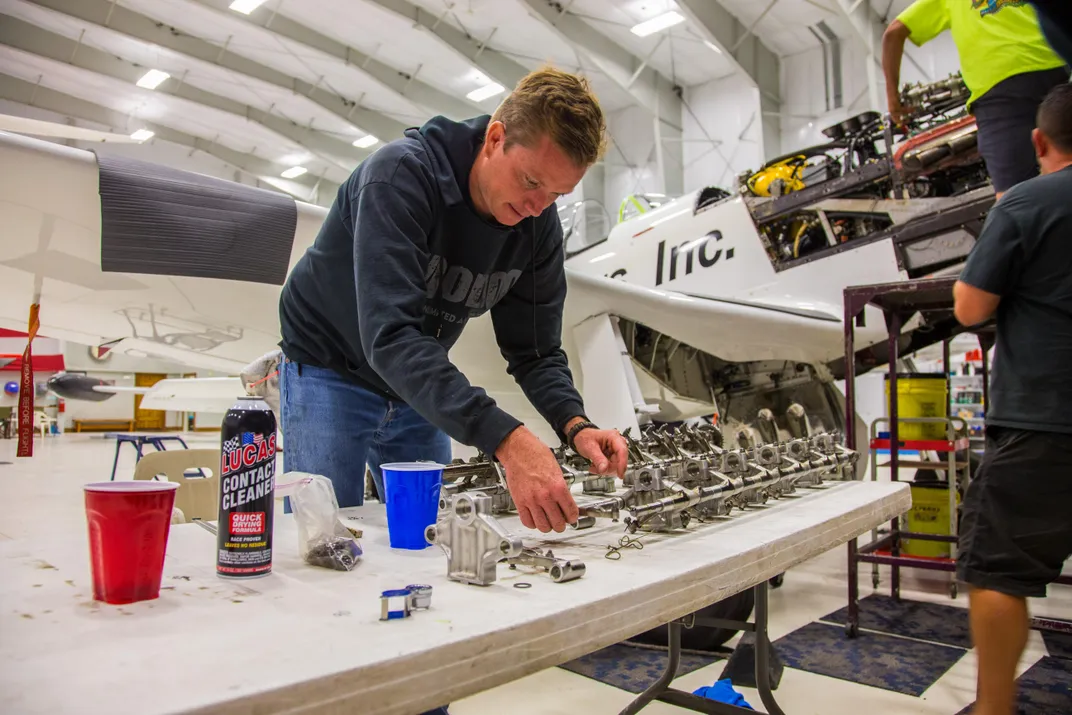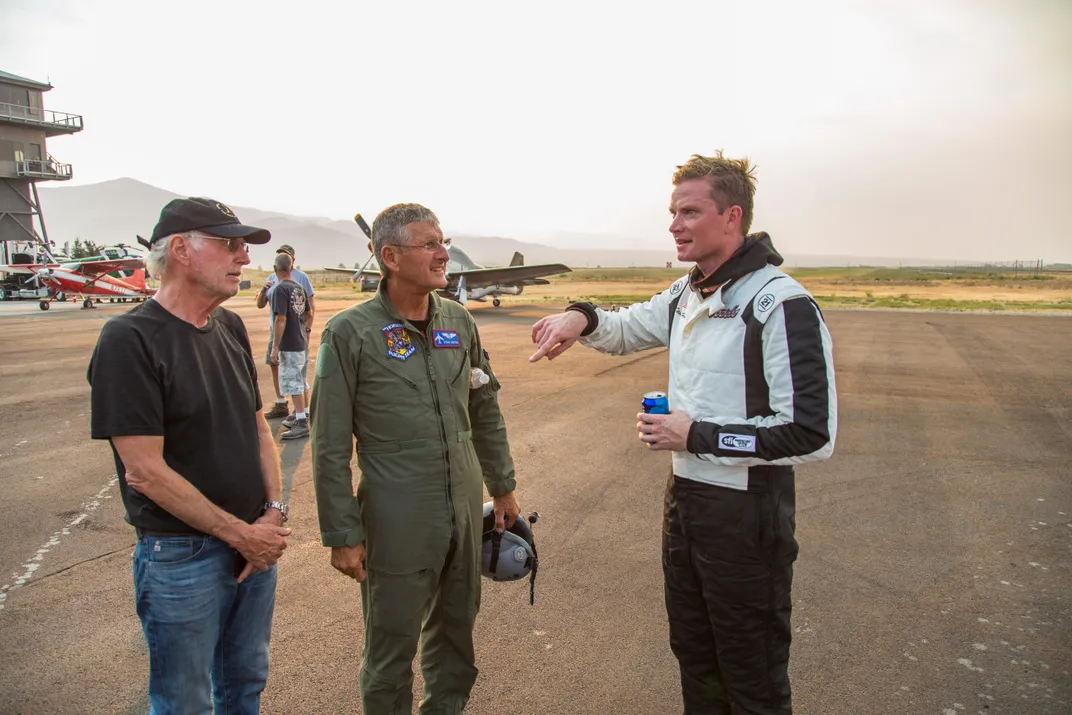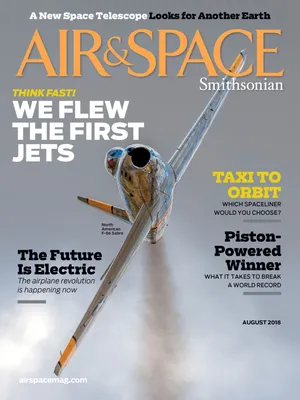World’s Fastest Piston-Power Airplane
A star team led by a racing phenom grabbed the record. But there’s one left to break.
/https://tf-cmsv2-smithsonianmag-media.s3.amazonaws.com/filer/75/e1/75e1cb09-f0d1-479e-a794-517742417ff7/11g_aug2018_scottgermain_front_sg_5286_live.jpg)
The roar and concussion were startling. Clocked at 554.69 mph, the ultra-modified P-51 racer Voodoo shot by and was gone. Its first pass over the three-kilometer straightaway took 12 seconds.
I was watching air racing superstar Steven Hinton attempt to do what his father had done 38 years before: set the three-kilometer speed record for piston-engine, propeller-driven aircraft. For raceplane pilots, the three-kilometer record (1.86 miles) is an Olympian goal, captured by the greatest pilots in history. “This record has been around since the beginning of aviation,” says the younger Hinton, pointing out that the fastest jet record wasn’t established until almost 1950. “It connects the generations.”
He mentions Jimmy Doolittle, who set the record in 1925 flying a Curtiss seaplane, one day after he won the Schneider Trophy for the United States. Eight pilots, including Amelia Earhart, beat Doolittle’s record, but he won it back in 1932, flying the storied Gee Bee R-1 at the Cleveland National Air Races. After World War II, a fascination with jets pulled the focus away from the piston-engine record, and it slept for 30 years. In 1969, air race champion Darryl Greenamyer decided that 30 years was long enough for the record to be held by a German Messerschmitt. His modified Bearcat Conquest 1 brought the title back to the United States and earned the Bearcat a place in the National Air and Space Museum.
Last September, Hinton was chasing the record set a generation later, in 1989, by another famous pilot, Lyle Shelton, in another famous Bearcat, Rare Bear. The massive racer, built from a wreck, had been perfected over two decades of competition. Some thought Shelton’s speed—528.31 mph—would never be beaten. And according to the Fédération Aéronautique Internationale, the body governing worldwide aviation competition, it won’t. The FAI database states that Shelton’s record has been “retired by changes of the sporting code.” But Art Greenfield, of the U.S. National Aeronautic Association, says the FAI statement is wrong, and he wants the international organization to correct its database. “We changed the rules, but we did not want to change history,” he says.
Greenfield, the NAA director of contests and records, explains that when Shelton set the speed record, he wasn’t required to specify the weight of the airplane; his speed was entered in the NAA database in an “unlimited” category. Today, a challenger must specify one of 23 categories determined by an airplane’s takeoff weight; if a record is set, it applies to that weight class alone. There is no longer an unlimited category. But, says Greenfield, if a challenger flies at a speed one percent faster than Shelton’s 528.31 mph, Shelton’s name will disappear from the record list. Until that happens, Shelton stays. His record is there to beat.
Modified racers like Mustangs and Bearcats fall in the category weighing between 3,000 and 6,000 kilograms (about 6,600 to 13,200 pounds). In that category, the first to set the record under the new rules was Will Whiteside, flying a modified Yak-3U, Steadfast. In 2011, he hit 416 mph, a tremendous speed for a Yak but nowhere near what Bearcats like Rare Bear and Mustangs like the current Reno champion Strega can do. Topping 416 would be easy. But Steven Hinton—Stevo, as he’s called by friends and fans to distinguish him from his famous father, also named Steve—was aiming higher.
The younger Steve Hinton (he is not a junior; father and son have different middle names) was born into warbird royalty. His grandfather Ed Maloney, who in 1957 founded the Planes of Fame Air Museum in Chino, California, was one of the first to recognize the historical value of World War II airplanes, and he did more to preserve them than any other single collector in the country. In a story that every race fan knows by heart, the senior Hinton was best friends from second grade on with Maloney’s son Jim, and the pair knocked around the museum as kids and became pilots and precocious warbird experts together. (They also became family when Hinton married his friend’s sister Karen.) Jim Maloney died in an airplane crash in 1983; Hinton became a fixture at the National Championship Air Races in Reno, winning Unlimited Gold in 1978 and 1985 and, in 1990, taking over from the legendary Bob Hoover as the Unlimited pace plane pilot, the one who sets the pace for the formation of racers as they enter the course. The younger Hinton entered racing as a crew member on Strega, Bill “Tiger” Destefani’s hot-rod Mustang, and in 2009, as Strega’s 22-year-old pilot, became the youngest person in history to win an Unlimited Gold race. (There is no longer an unlimited category in speed records, but that has nothing to do with the Unlimited racing class, for piston-driven airplanes weighing more than 4,500 pounds.)
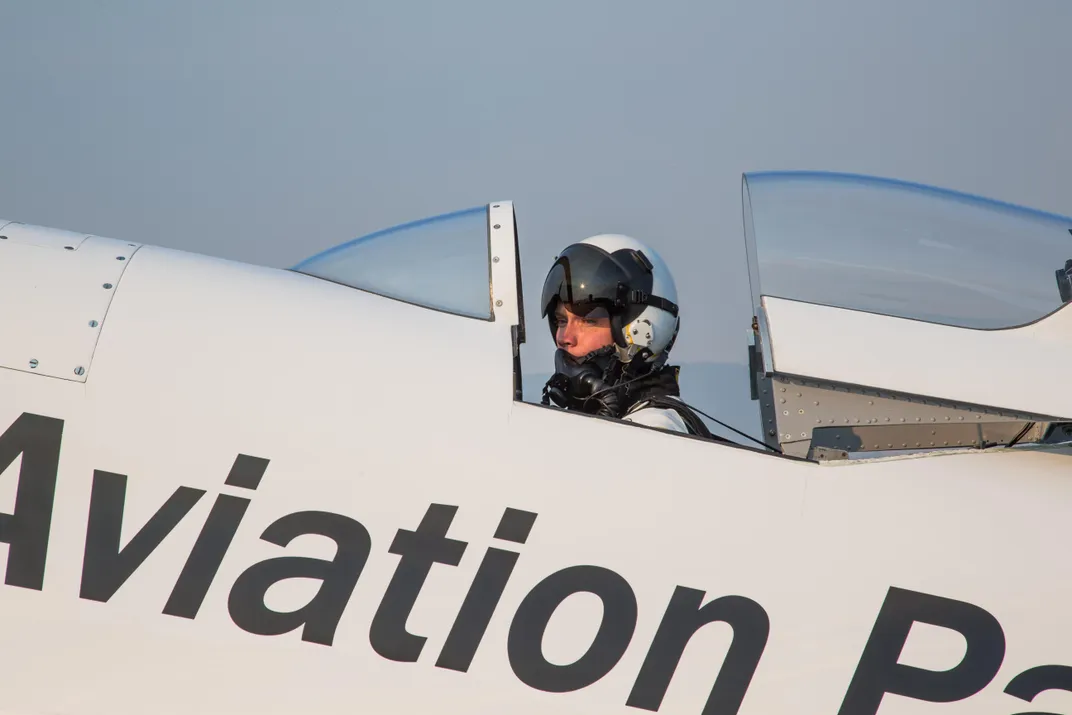
When he was 15 or 16, Stevo Hinton says, he found in the attic his dad’s three-kilometer speed trophy. “That was about the same time I got bit by the air racing bug real hard,” he remembers. He started reading about the speed record, researching its history in the Planes of Fame museum library. “It made me a more goal-oriented person,” he says. Learning about it made him think “This is something I really want to do.” He kept the old trophy on a shelf in his bedroom, a daily reminder of a goal he wasn’t sure would ever be within his reach.
A Horse of a Different Color
“When they designed these planes back in the ’40s, they didn’t have any of the computational fluid dynamics [CFD] tools we have today,” says Danny Sikavi, chief of aerodynamics for Aviation Partners, a firm that designs and installs wingtip devices, or winglets, on corporate jets and airliners to make them more fuel efficient. Sikavi’s team used CFD software to analyze Voodoo’s airfoils. He says, “It was getting pretty strong shocks on both the upper and lower surfaces.”
In 2010, when he was still with the Strega racing team, Hinton met Aviation Partners CEO Joe Clark. Clark talked to him about sponsoring Strega for a record attempt. “We couldn’t put it together at the time,” says Hinton. “Tiger didn’t want to risk his asset for little or no return, which is understandable. Who risks a $2 million asset for nothing but personal satisfaction?”
As it turned out, Voodoo owner Bob Button. But in 2013, when Hinton switched to the Voodoo team, the Mustang was not the airplane Strega had been. “It flew horrible,” Hinton said. “The airfoils on the wing, horizontal, and vertical [stabilizers] were incorrect. The incidence on the tail was wrong. The canopy never fit well. The scoop was old. There were a lot of things I thought we could do better.”
From 2013 through 2015, Hinton, transferring all he had learned by working on Strega, helped his new team bring Voodoo to the sharp edge of piston-engine performance. In 2016, after his third Unlimited win in Voodoo, Hinton found that Clark was still interested in sponsoring a run at the record. And Clark had an idea for making the now fast Mustang even faster.
“I didn’t want to just throw money at the record,” says Clark. “Anybody can do that. I wanted to add value.”
Clark’s aerodynamicists and engineers went to work.
The shock waves Sikavi found in CFD studies were the result of supersonic airflow over portions of the wing, and they cause abrupt increases in drag. The engineers began to look for ways to weaken the shocks or delay their formation. With computer-aided design and CFD software, they prescribed pressure distribution over the wing. They then created shapes that eliminated or weakened the shock. They maintained the profiles of portions that were shock-free.
“Most of the changes occurred on the wing’s upper surface,” Sikavi says. “On the lower surface, we were limited to the inner portion of the wing.”
The final shape of the airfoils increased the airplane’s critical Mach number, the speed at which drag rises rapidly. “In other words,” Sikavi says, “we had the same amount of drag from the wing but at a higher airspeed.” The modification increased Voodoo’s critical Mach from 0.72 to 0.76. That difference may seem small, but it represents a remarkable performance gain: at 7,000 feet, an additional 28 mph on the same horsepower.
The design was made final in February 2017, and Hinton’s team, working with Aviation Partners, began the physical modifications for a run at the record planned for July. To produce the most precise airfoil, Voodoo’s wings were de-mated, stripped to bare metal, then laser mapped. Using the digital data, Aviation Partners milled 35 carbon-fiber pieces to be applied to the wing to change its shape.
For two weeks of 14-hour days, Hinton and teammate B.J. Healis installed the machined parts at precisely mapped locations on Voodoo’s wings with corrosion-inhibiting adhesive and rivets. After the final piece was installed, the team had to fill and smooth the new surface. Then the hard part began: Hinton, Healis, and teammate Ben Marsh, who had worked on Voodoo’s wing the last time it was profiled, spent hundreds of hours sanding, refilling, measuring, and sanding again. Once the work was complete, the wing was painted, clear-coated, polished, and re-mated to the fuselage.
As the modifications were getting under way, Joe Clark requested another big transformation for the racer. Voodoo lost its garish purple, orange, and green race paint and emerged at the end of the summer wearing a classy, creamy white. (The photos of white Voodoo that the team posted on the Internet caused their own shock waves among race fans grown accustomed to the racing livery.) A number of the aircraft Clark’s company had used as testbeds had worn white, and Clark and Hinton decided that a white airplane would provide the best billboard.
The Fastest Piston-Engine Airplanes
Power and Pressure
As work and planning progressed, the team selected Clark’s private ranch and airstrip in Idaho’s high country as the location for the attempt. High summer temperatures and a 5,500-foot elevation made the airstrip optimal. For maximum speed, airplanes like the Mustang perform best in thin air at high altitudes. Less dense air nets a higher true airspeed, the actual speed an aircraft moves through the atmosphere (as opposed to indicated speed, calculated by the amount of air molecules entering instruments). High temperature offers additional help for the same reason; hot air is less dense.
The reverse is true when it comes to the engine; less dense air means the engine will generate less horsepower. Fortunately, the supercharger in racing-modified V-12 engines can shove more air into the cylinders, producing wild amounts of “boost,” or increased manifold pressure. The internal combustion engine mixes fuel and air; the more air you can pump through the engine (via the supercharger) and the more fuel (via the pump and metered by the carburetor), the more power you can make.
Stock Mustang engines produce 1,425 horsepower at 60 inches of manifold pressure and 3,000 rpm. The supercharger in a racing V-12 can produce up to 140 inches of manifold pressure. For the record attempt, Voodoo’s engine produced 3,100 horsepower. (Few of these settings are automatic. Pilots adjust manifold pressure and rpms as they fly.)
Stuffing more air leads to another problem: too much heat. The thermodynamics experts counter the heat with massive amounts of ADI, anti-detonation injection, a 50/50 mix of distilled water and methanol sprayed into the engine.
Air races are rough on engines, and sometimes a race is lost because the engine can’t stand up to the demands placed on it. (In 2015, after five laps, engine problems forced Hinton out of the race.) At the 2016 event, Hinton didn’t need to use big power to win; nevertheless, after the race, Bob Button sent the engine to José Flores, owner of Vintage V-12s, in Tehachapi, California, one of the most respected engine shops in the country. Flores is a master at building Merlins that will rage around the race course and survive the inferno. A few months after the the Merlin arrived in Tehachapi, the Voodoo team sent a second one: insurance against problems with the primary.
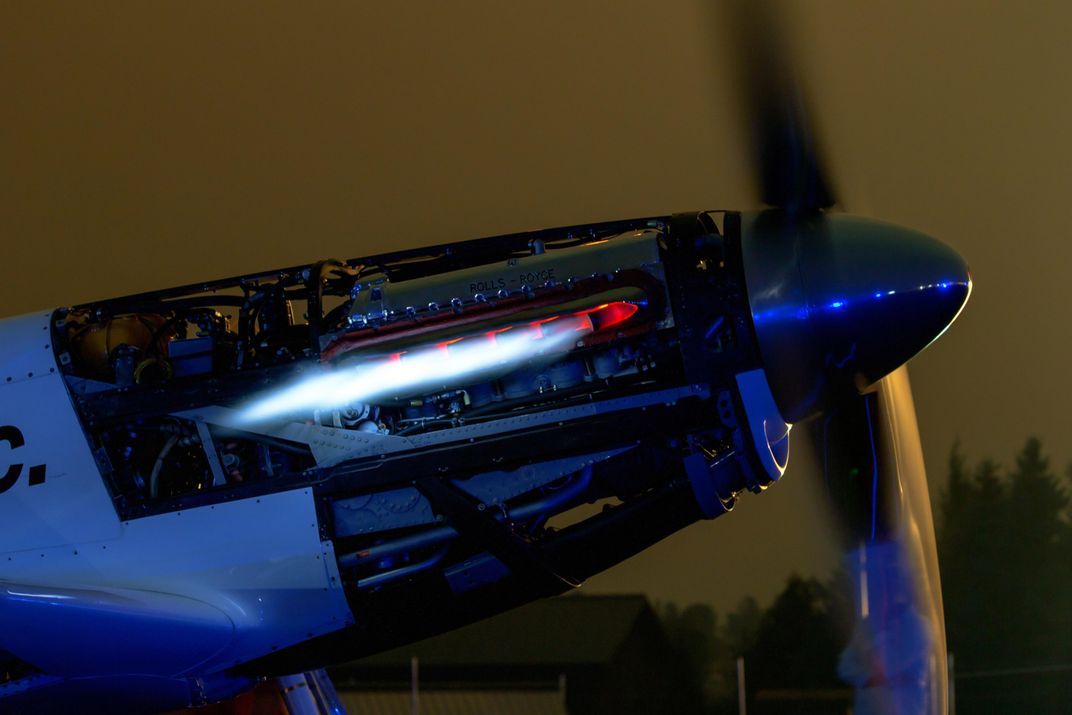
The proof that the engine would sustain its power through the four laps of the record attempt would come only during the attempt itself. But to get an indication of how it would behave, the team set up for flight testing.
Early tests showed that the airframe modifications had resulted in significant gains in performance. “The airplane accelerated much faster to the high-speed realm,” Hinton says. “At 100 inches [of manifold pressure], I’d never seen a speed that fast before.”
Delays in the fabrication of the wing’s puzzle pieces and in the laborious application of those pieces had caused the late July window to slip to the last days of August. This schedule shoved the record attempt up against the 2017 Reno air races, to be held only a week and a half later. The crew had previously decided to concentrate solely on the speed record; if they didn’t blow both engines, they’d discuss racing at Reno.
Moments of Truth
The nine months leading up to the record attempt had been grueling for Hinton. For much of the final three weeks, I spent days with the crew as they worked, overcame obstacles, and kept their focus on the goal. By that time, Hinton hadn’t been home in months, yet despite the long hours, he remained enthusiastic and friendly. Work had started on the airplane the previous December, and from May onward he had led a small team working 16 to 18 hours a day, seven days a week—without pay. The effort was entirely volunteer. His crew was small and skilled; every member was able to do just about any job. Frank Young, a Voodoo crew member from its first day of racing, knew every nut and bolt of the aircraft; B.J. Healis, an unparalleled aircraft mechanic, was famous as a team player; Bernie Vasquez, a warbird and race pilot himself, could handle everything from paint and body work to engine work to manning the crew radio and telemetry; Ben Marsh knew Voodoo’s wing better than anybody; and Cory O’Bryan, Hinton’s friend and former roommate, was an experienced airplane painter. Andy Chiavetta, who had built Darryl Greenamyer’s Sport-class winning Lancair and had become himself a fixture at Reno, also helped out.
Hinton managed the operation, and his fingerprints were on every part of the airplane. I watched him checking Merlin Fingers, the custom rocker arms within the engine’s valve train, which can develop tiny cracks at race power. The next hour he might be juicing the high-octane racing gas with liquid manganese (that helps prevent detonation) or inspecting the course from a helicopter to pick out landmarks.
In the Reno pantheon, Hinton is a rarity. Unlike most of the pilots who fly the big, expensive Unlimited racers, he’s not a specialist brought in only to fly the airplane. He’s a warbird mechanic, who learned from old-school pilots and guys with 60-weight oil under their fingernails. “I enjoy the work,” Hinton says. “You’re trying to figure out what makes these 70-year-old machines tick. If something breaks, you have to understand why it broke. There are no computers to diagnose the problem. It’s something that challenges you and pushes you.” Hinton was about to get pushed.
The team had measured and marked the course, and Voodoo was ready for the record flight. Hinton’s father was on hand to pilot a Lockheed T-33 jet, equipped with a new gyro-stabilized camera system provided by Pursuit Aviation. He would also be available to play the role he had played for dozens of pilots in dozens of Unlimited races: If something goes wrong, it’s Steve Hinton’s voice the pilot hears on the radio, offering advice, talking the pilot through the emergency.
Stevo climbed into Voodoo, took off, and made two maximum-power passes to measure how much fuel and ADI were consumed so the team could calculate the minimum needed at race power, plus some reserve, so Hinton wouldn’t be carrying unnecessary liquid—and weight. After he landed, the crew measured how much was left in the tanks. The news wasn’t good. The engine was flowing too much fuel—so much, in fact, that the airplane couldn’t carry enough for the required four passes. The trouble turned out to be a faulty carburetor. A spare was readied and installed, and Hinton took off to test it at high power.
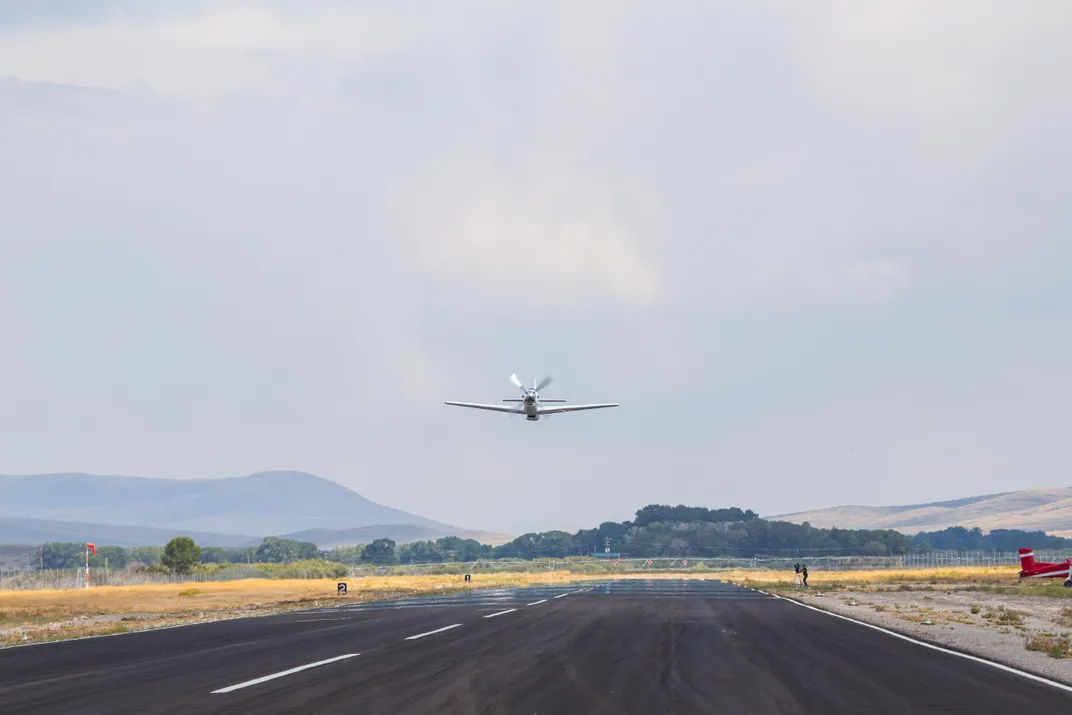
As he brought the throttle up through 100 inches of manifold pressure, the engine violently backfired. A mighty jolt to the airframe was accompanied by belches of smoke from both sides of the engine. Hinton immediately brought the power back and arced to a safe landing.
I could see stress and exhaustion showing in his bearing as Hinton walked away from the airplane. He was trying to hold it together; at the same time, he needed to vent his frustration. He fired off an expletive before joining the crew to analyze what had happened.
The engine backfire was serious. The crew tore into the engine and discovered a problem with one of the valve seats, a metal ring against which the valve rests when it’s closed. The seat hindered valve movement, and that in turn disrupted fuel flow, causing the backfire. The engine wasn’t damaged, but the attempt couldn’t be made until the part was replaced. The team deliberated: Should they fix this engine or install the backup? It was a gamble they couldn’t afford to lose. After a phone conference with Flores, they removed the offending bank of cylinders and flew it to his shop for repair. The decision was to stick with engine number one; at least they knew what they had.
Three days were lost, and when the repaired bank was installed and ready, August had ended. Weather became the next problem. Smoke from numerous wildfires in the Pacific Northwest had fouled the air and limited visibility to three miles, an uncomfortable limit for a pilot who would be flying at around 792 feet per second. Worse, the meteorologists were forecasting lower temperatures over the next several days. The window for Hinton’s attempt was closing.
In the smoky afternoon sun on September 2, Hinton’s fiancée Jane Lynch (today, she’s Jane Hinton) walked him out to Voodoo. Cockpit video cameras and the FAI’s tracking equipment were turned on, and, after a few fist-bumps with the crew, Hinton climbed into the cockpit to begin his methodical strap-in routine. The repaired Merlin fired to life, and Voodoo taxied out for takeoff.
Hinton transmitted to Vasquez from the end of the runway: “I like it.”
The telemetry screen in front of Vasquez showed Voodoo’s vital signs in real time. Hinton lined up on the runway, pushed the throttle forward, and began his takeoff roll.
“ADI,” said Vasquez. “Got it,” Hinton replied. Voodoo wailed by center field and gently left the ground; Hinton folded the landing gear and banked downwind to begin the attempt. The Merlin’s sound trailed off into a muted buzz somewhere in the dull, orange sky.
In Voodoo’s cockpit, Hinton was watching the engine vital signs on the instrument panel before him. He was constantly tweaking the ADI with a valve on the panel that fine-tunes the amount of water/methanol mix flowing to the engine. The workload was high; any change in power, speed, or altitude required a small change in ADI. But the pilot was at the top of his game. He had won Reno seven times by flying consistent, machine-like laps and hitting the same piece of sky every time.
After the first pass, Hinton banked right to perform the turnaround, a 2.5-G maneuver designed to balance scrubbing speed without expending too much time, fuel, and ADI. It was a delicate act. With his altimeter and vertical speed needles bouncing wildly at the extreme airspeed, Hinton had to somehow make sense of their readings and stay within the required 1,500 feet of the ground.
The second pass, at 527.34 mph, was almost 30 mph slower than the first; the effect of the entry dive had worn off. The third reached 528.48 mph, then another fade of ungodly engine howl to the west. The crew, watching through binoculars, reported seeing oil—massive streaks of exhaust staining the fuselage sides.
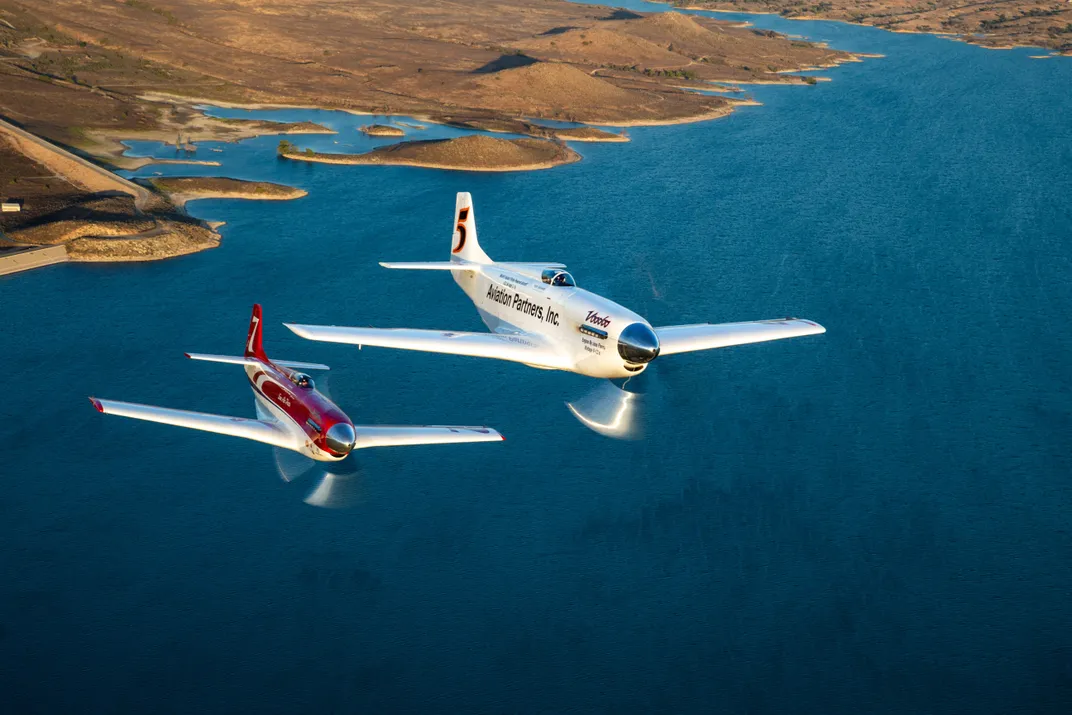
In the cockpit, Hinton knew from the very start that the engine wasn’t making the required power. The manifold pressure gauge read 117 inches; it should have been 130 or more.
During the third pass, Hinton caught the oil pressure dropping from 120 to 70 pounds. The drop was a sign that the engine was failing. Vasquez came over the radio a second later with the same bad news.
“I see it,” Hinton radioed.
Should he continue the run and hope the engine held together or reduce power and land? Was there an instant when he flashed on the pilots who had pushed hard and crashed at Reno? If he pulled up now, what would all the months of work mean? There wouldn’t be enough time to try again.
Hinton banked steeply. Instead of the 2.5-G turn, he pulled 4.5 Gs to head back toward the runway for the fourth and final run. The sharp bank was his decision to get the airplane pointed toward the runway immediately, in case the engine did quit, or worse, blew up. He said later, “Those three seconds were the most intense of the entire attempt.”
The higher-G turn scrubbed off a lot more speed; that would hurt the average. The white dot to the west grew into an airplane again as he lined up for the last pass.
As Hinton and Voodoo flashed over the runway one final time, Vasquez keyed his mic so the pilot could hear the magnificent sound for himself. “Thanks for that,” Hinton replied.
Failing engine and all, Voodoo clocked at 515.62 mph on the final pass.
The Final Reckoning
When Voodoo was towed inside, it looked beat. After a short time, the FAI observer had crunched the preliminary data and approached the small crowd waiting in the hangar. His announcement: 531.53 mph (later revised to 531.64). Voodoo had shattered the weight-class record of 416 mph. The official, knowing that Hinton was gunning for Shelton’s record, also noted that Hinton had not hit his goal. A number of us murmured disappointment, but Bob Button, his booming voice filling the hangar, changed the mood: “Hey! We set the record, people!” Button shouted. “We are the fastest piston-engine airplane in the world!”
Gathered around the stained, dripping racer, people began to exchange hugs and the buzz of talk and laughter grew louder. As the celebration gained momentum, a Voodoo crew member used his finger to scrawl some numbers in the engine exhaust stain on the raceplane’s fuselage: “531>528.” Hinton had beaten Shelton’s speed.
But not by one percent.
In the decades ahead, many will tell the story, which sounds like a fairy tale, of a young virtuoso who reigned at Reno for almost a decade then reached for his childhood dream. And they will all wince when they repeat the phrase “but not by one percent.” But is that how the story ends?
After the record win, Button donated Voodoo to the Planes of Fame museum, and recently, as Hinton was reflecting on the record, he said, “There are quite a few things we’d change if we were lucky enough to do it again. We feel like the airplane can go faster. We left some on the table.” The magic number of one percent greater than Shelton’s 528.31 mph is 533.59. And one percent faster than Hinton’s own record is 536.95. “We feel like the airplane is capable of 540,” Hinton says.
Hinton, again reflectively, says he’s trying to start raising the money that would be required for another run at the record. Interviewing the crew about their 2017 experience, I can guess that it wouldn’t be hard to put the band back together. “If you leave something on the table and feel like there’s room for improvement,” Hinton says, “and have a path to get there…,” he trails off.
Is it possible to rewrite the ending of a fairy tale? There may be another entire chapter. Steve Hinton is only 30 years old.
